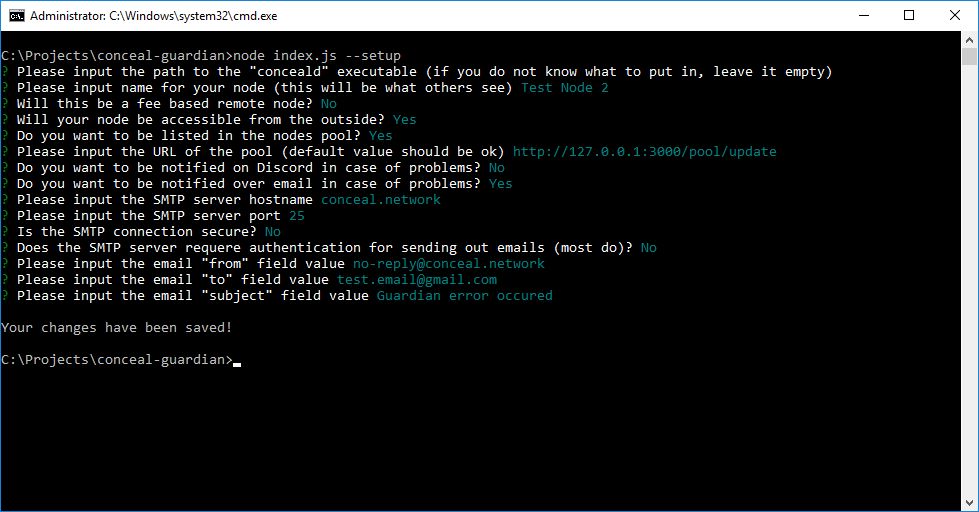Please take note that you will need administrative rights for working with service commands. On Linux and macOS ensure that you have superuser privileges. On Windows, be sure you are using "Run as administrator" option.
Download the appropriate binary for your OS here and extract them to the directory of your choice.
If running on Linux or macOS, before running conceald, Boost v1.58 must be installed. In case your package manager installs different Boost version (as it is with Ubuntu 18.10 or higher), conceald executable will have to be built manually as described here. You can check installed Boost version by running dpkg -s libboost-dev | grep 'Version' on Linux or brew info boost on macOS if you installed it with Homebrew.
On Debian based system (Debian, Ubuntu, Mint...) you can use package manager:
$ sudo apt update
$ sudo apt install -y libboost-all-devThe easiest way to install dependencies on macOS is by using Homebrew. Once Homebrew is installed, proceed with installing Boost:
$ brew install boostYou can use guided setup to configure your Guardian. On Linux or macOS, run:
./guardian-linux64 --setupor on Windows simply double click on setup.bat.
Each OS has the executable of a different name so be sure to use the appropriate one for your OS.
You will be presented with few questions, answer them and you will be ready to go.
Questions explanations:
Please input the path to the "conceald" executable (if you do not know what to put in, leave it empty)
Absolute path to conceald daemon executable. If left empty the Guardian will try to look in project's directory and use that one. If conceald is not found it will try to download the latest one.
NOTE: The automatic download and install works for Windows and Ubuntu 16.04 and 18.04 only. For any other OS you need to compile your own daemon.
Please input name for your node (this will be what others see)
This is the name of the node that will be visible in the pool. It is a mandatory input.
Will this be a fee based remote node?
If you want to run your node as remote node with a fee, then answer YES to this.
Please input the fee address for your node (earnings will be sent to that address)
Address where to send fees if Guardian is running as fee based remote node.
Will your node be accessible from the outside?
This controls if your node will be accessible from the internet or not. If you run this internally then answer NO. If people will use it from the internet and connect to it, then you need to answer YES.
Will your node have auto update enabled?
This option controls if your Guardian will try to autoupdate the daemon (node). If true then the Guardian will check every hour if there is a new version available and update it, if it is.
Do you want to be listed in the nodes pool?
Decide if you will be listed in the explorer nodes pool.
Please input the URL of the pool (default value should be ok)
If previous answer was YES then you select the pool address here. The default value should bi fine, so just press ENTER.
Do you want to be notified on Discord in case of problems?
Answer YES if you want to be notified over the Discord in case of a problem with node. You will be asked further questions if you answered YES.
Do you want to be notified over email in case of problems?
Answer YES if you want to be notified over the email in case of a problem with node. You will be asked further questions if you answered YES.
To install system service, run:
./guardian-linux64 --service installOnce the service is installed, you can simply run it with:
./guardian-linux64 --service startTo stop the service use the command:
./guardian-linux64 --service stopAnd to remove it just use:
./guardian-linux64 --service removeTo see if the service is running correctly and current status, use:
./guardian-linux64 --service statusYou can see help at any time by using:
./guardian-linux64 --helpThe Guardian supports two mode of operations:
- You don't have a daemon (
conceald) pre-installed, the Guardian takes care of everything. - You have the daemon pre-installed and the Guardian monitors that instance.
If you have a type 1 installation, you can use the build in updater for the daemon. Simply do:
./guardian-linux64 --node updateThe Guardian will download and update the latest stable daemon (conceald). Or if you have a fresh install and don't have the daemon yet, the Guardian will download it and install it on the first run automatically. Note however, that precompiled binaries are only available for Windows and for Ubuntu 16.04 and 18.04 LTS. On other Linux versions, you will have to compile the daemon binaries yourself as described here.
Updating of the Guardian itself is similar and as easy as updating the Node daemon. Simply type:
./guardian-linux64 --updateThe Guardian will download and update itself.
